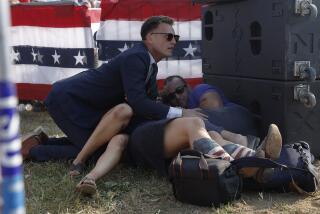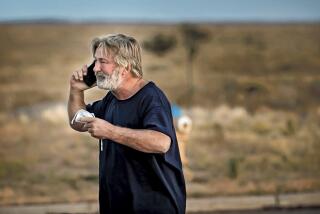Pilots Ramp Up Campaign to Allow Guns in Cockpit
To be certified by the Federal Aviation Administration, an aircraft windshield must be able to withstand the impact of an 8-pound chicken shot directly into the double-paned panel. But can a windshield hold up under the force of a bullet?
That is one of the central questions in the ongoing debate over whether pilots should be allowed to carry guns in the cockpit. After an intense eight-month campaign by pilots to be allowed to use firearms, the Bush administration last week denied them permission to do so.
Now pilots are trying to rally support behind a House bill that would let them carry arms. A companion measure was introduced in the Senate last week.
The debate is forcing Congress to reevaluate whether an aviation security law it enacted last fall does enough to prevent hijackings. And its outcome is likely to foreshadow how far Americans are willing to go to protect the nation’s aviation system.
The arguments both for and against arming pilots are compelling. Pilots call themselves the last line of defense--citing the eight who died Sept. 11 with no way to protect themselves other than their bare hands and emergency axes. Arming them would deter terrorists, they say.
Opponents argue that a pilot could accidentally shoot part of the plane, or an innocent passenger, or that a terrorist could wrestle the gun away and commandeer the aircraft.
The pitch for pistol-packing pilots is not without precedent. To guard against hijackings, about a dozen pilots were selected by the FBI in the mid-1970s to receive training to carry a firearm, said retired Capt. Stephen Luckey earlier this month in testimony before the House Subcommittee on Aviation.
For 15 years, Luckey wore a gun at all times in the cockpit--saying it brought “an increased level of responsibility and restriction.” In fact, pilots were permitted to carry a gun with the consent of their airline until as recently as July, when the FAA rescinded the program.
Now pilots are battling powerful opposition to providing them with arms. Transportation Secretary Norman Y. Mineta and Transportation Security Administration chief John W. Magaw disapprove of the plan. The airlines also don’t favor arming pilots--citing potential danger to passengers and crew members.
“Fortified, reinforced cockpit doors, combined with armed air marshals, provide adequate protection on board to pilots and passengers,” said Michael Wascom, a spokesman for the Air Transport Assn., an airline trade group.
Pilots argue that these measures might not be enough to stop hijackers bent on taking over a plane and turning it into a missile. Reinforced cockpit doors can be breached, or attackers could strike when pilots leave the cockpit to use the restroom, they say. The airlines have until April 2003 to install fortified cockpit doors.
In addition, the federal air marshal program will cover only a tiny fraction of the domestic aviation system’s 30,000 or so daily flights, said Capt. Gary Boettcher, who flies 737-800s to the Caribbean.
Pilots propose a voluntary arms program, to be administered by the Department of Transportation, under which they would receive 48 hours of training and be deputized as federal law enforcement officers. Being deputized would protect pilots and airlines from liability by placing responsibility for the program with the government.
The proposal would restrict gun use to the cockpit and make it only a last resort, Luckey said. The program, mirrored in legislation proposed in Congress, would require pilots to undergo criminal background checks, psychological tests and classroom instruction on employing a weapon.
To receive a license, pilots would have to score well on field exercises in which they would fire as many as 2,200 rounds in a simulated cockpit, Boettcher said. Pilots also suggest that the government could choose ammunition--such as “frangible” bullets, which break apart when they hit metal or other hard objects--that would be less dangerous in the confines of an aircraft.
Pilots unions counter that 70% of the nation’s pilots are former military or law enforcement personnel and that many participate in the National Guard and the Air Force Reserve. In fact, some of these pilots flew fighter jets over Washington, New York and Chicago when off duty in the months after the terrorist attacks, Billie Vincent, former FAA security chief, said in comments submitted to the FAA.
Instead of arming pilots, some airlines, such as United, favor the use of stun guns that would be kept locked away in the cockpit and then taken out and holstered within reach of the pilots during flight.
These weapons, known as Tasers, would have been particularly effective during an incident in February on a United Airlines flight from Miami to Buenos Aires when a passenger jammed his body through a panel in the cockpit door.
Instead of hitting him with an emergency ax--as a co-pilot did with little success, prompting passengers to rush forward to help--the crew could have relied on a stun gun to incapacitate him, said Capt. Henry P. Krakowski, vice president for safety, security and quality assurance at United, in testimony earlier this month before the House Aviation Subcommittee.
Pilots argue that stun guns are not effective against multiple attackers and can be foiled by terrorists trained to anticipate their effects.
But Tasers, if misfired, don’t run the risk of shattering instruments on the flight deck or harming other parts of the aircraft, as firearms do, Krakowski said.
Pilots counter that the likelihood they would misfire in the confined space of the cockpit is low, coupled with the fact that an airplane can withstand a certain amount of gunfire.
It’s a myth that an airplane will rapidly depressurize and crash if a bullet pierces the fuselage, said Capt. Dennis J. Dolan, who flies 737-800s for Delta Airlines. Design experts at Boeing concur, saying FAA certification requirements mandate that an aircraft survive a 20-square-foot hole.
With smaller holes like those caused by a bullet, a plane wouldn’t come apart if it started to depressurize, and people would still be able to breathe because of numerous vents throughout the aircraft, said Liz Verdier, a spokeswoman for Boeing Co.
If a passenger window were shattered by a bullet, unbelted travelers near the area would be in danger--and pilots would have to immediately decrease altitude to regulate the pressure inside the aircraft--but the plane could still land safely, Verdier said.
“The windows and the windshield can withstand a bullet,” she added. “In spite of what people have seen in the movies, an aircraft doesn’t explode like a balloon when a bullet pierces the fuselage.”
More to Read
Sign up for Essential California
The most important California stories and recommendations in your inbox every morning.
You may occasionally receive promotional content from the Los Angeles Times.










